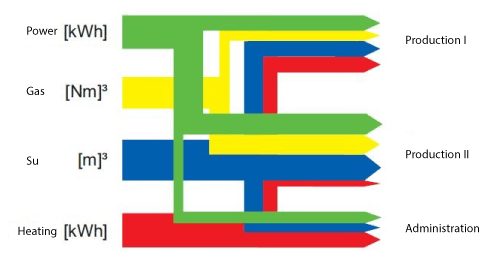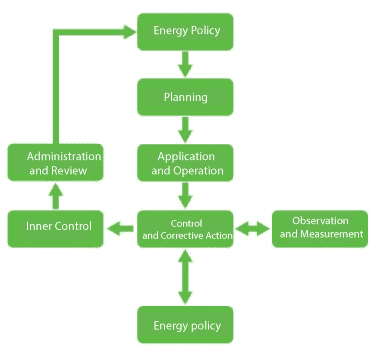
Energy Efficiency with Iso 50001 Energy Management
Globally, all companies face with increasing energy costs. Firms that are struggling to compete with the pressure of increasing costs prefer the way to go saving sources for all expenses. Energy, one of the most important expense items, is at the head of the issues that are beginning to be saved. Based on measurement, which is the most important starting point of saving, organizations in this standard set out the measurement of all energy inputs and the external factors that cause it. In addition, the increase in greenhouse gas released as a result of the energy used can be reduced by saving energy. In the light of this information, organizations can realize energy management with sustainable environmental awareness through efficient energy use
I. INTRODUCTION
ISO 50001 stands out as an international standard that guides organizations of all sizes to systematically improve energy performance and promote efficient energy management in all their processes. It is one of the few management systems that offer measurable cost advantages to organizations. It gives your business more transparency and enables you to implement effective practices in energy management by showing how energy is consumed along your system chain. Within the scope of the ISO 50001 energy management system, it provides systematic improvements in energy efficiency and consumption, while at the same time enhancing your company’s reputation and environmental performance.

II. ABOUT ISO 50001
The ISO 50001 energy management system is a common vision of energy management experts from over 50 countries for many years. It represents the latest energy management practices based on existing national and international standards. ISO 50001 sets action plans for processes that provide the minimum energy needs of the plant, targets to reduce consumption, identifies energy performance indicators, identifies, prioritizes and records improvement opportunities to improve energy performance.

The ISO 50001 energy management system shows considerable similarity with the TS EN 16001: 2009 standard. The most important difference between them is that the standard item numbers are changed and more detailed. In this context, the evaluation of the useful life of the energy consumption and productivity of the hardware, products and services, which are the starting point of the design, modification and energy performance, evaluated by taking into consideration the calculation of the energy performance and the performance of the energy policy, including the purchase of efficient products and services and supporting designs that improve energy performance, the creation of an energy team alongside the management of the senior management, determination of measurement needs and calibration.
III. ENERGY FACTOR
One of the most important aspects of the ISO 50001 ENERGY MANAGEMENT SYSTEM standard is the definition of “energy factor”. What this means can be explained as follows: Assume that an establishment has changed the set values in the air for energy efficiency and that the air conditioners on that side are made to consume less electricity, so we expect the next electricity consumption to be less than the previous year’s electricity consumption. However, when we reach the end of the year, we see that our consumption values are higher than the previous year’s data. By looking at this result, it can be deduced that adjustments are not done correctly in the climate. However, the real factor here is the variability of outdoor weather conditions. Very cold or too hot air outside will affect the consumption of the air conditioner. Therefore, to be able to analyze the data correctly, the ISO 50001 ENERGY MANAGEMENT SYSTEM standard asks the user to first determine the following; While determining the amount of energy (electricity consumption in the climate), an energy factor (outdoor temperature) must be added next to it. Because, if these two are not evaluated together, the decision of healing cannot be given correctly. Or it is not possible to analyze whether the improvements made are correct or not.

It is necessary to monitor the energy consumption in a way linked to the energy factors and to initiate the corrective action in excess of the expected consumption. The standard is designed to help organizations continuously improve their energy performance for commercial and industrial buildings, optimize their usage and reduce operating costs and indirectly contribute to reducing greenhouse gas emissions. The formation of this system ensures, first and foremost, the fulfillment of environmental obligations and contributes to the consolidation of the ‘environmentally friendly’ corporate image. Another benefit is to reduce energy costs and increase competition power. When a cleaner working environment is provided, the greenhouse gas emissions are reduced and the contribution of the company to global warming is reduced. Energy Management System optimize the energy used per unit of output and wants the organization to constantly improve energy efficiency. It is necessary to identify the consumption points associated with energy, to make improvements according to their findings and to ensure their continuity. So – just as it is in the environmental management system – we are waiting for the recruitment of ‘Plan-Apply-Check-Take Prevention’ (PACT). The energy management system basically starts with energy analysis. It wants to find points where energy consumption is high and save them. It needs to increase our energy efficiency. Finally, it wants to switch to renewable energy sources.

IV. ISO 50001 ENERGY MANAGEMENT SYSTEM FOR WHO?
Energy costs, which have become one of the highest costs of industrial enterprises, can be reduced by disciplined and sustainable energy policies. Awareness is the key word to disappear to loss energy and high energy costs. The most effective way to achieve is an energy management system (ENYS) that is formed by a systematic approach to energy management and that can be measured every time. It is unimaginable that implementing an ISO 50001 energy management system would not benefit any organization that continues its activities using energy. Because the ISO 50001 energy management system standard is suitable for all installations regardless of sector size or geographical location. Those who have energy intensive work or who are subject to any legal obligation on greenhouse gas emission rates are of direct interest. The projects put into practice reduce energy consumption. Hence, greenhouse gas emission is blocked to a certain extent. Together with these, energy-related costs are reduced and kept under control.
V. CONCLUSION
Information on performance is obtained by monitoring the consumption of energy by controlling the use of devices and equipment found in facility. In this way, adverse environmental effects caused by the waste are reduced. The system is prepared and implemented for emission monitoring and reporting. In addition to all this, the reputation of the company and the society in relation to energy awareness is increased.
Ali Gökhan Yıldırım
Product & System Sales
Aktif Mühendislik
REFERENCES
[2] ISO 50001 – Energy management
[3]https://www.tuv-sud.com.tr/uploads/images/1457078064347222580332/sent-tuv-sud-iso-50001-ems-tr.pdf
[4]http://www.bmtrada.com.tr/ISO-50001.pdf
[5]http://www.ebso.org.tr/ebsomedia/documents/_28501121.pdf


